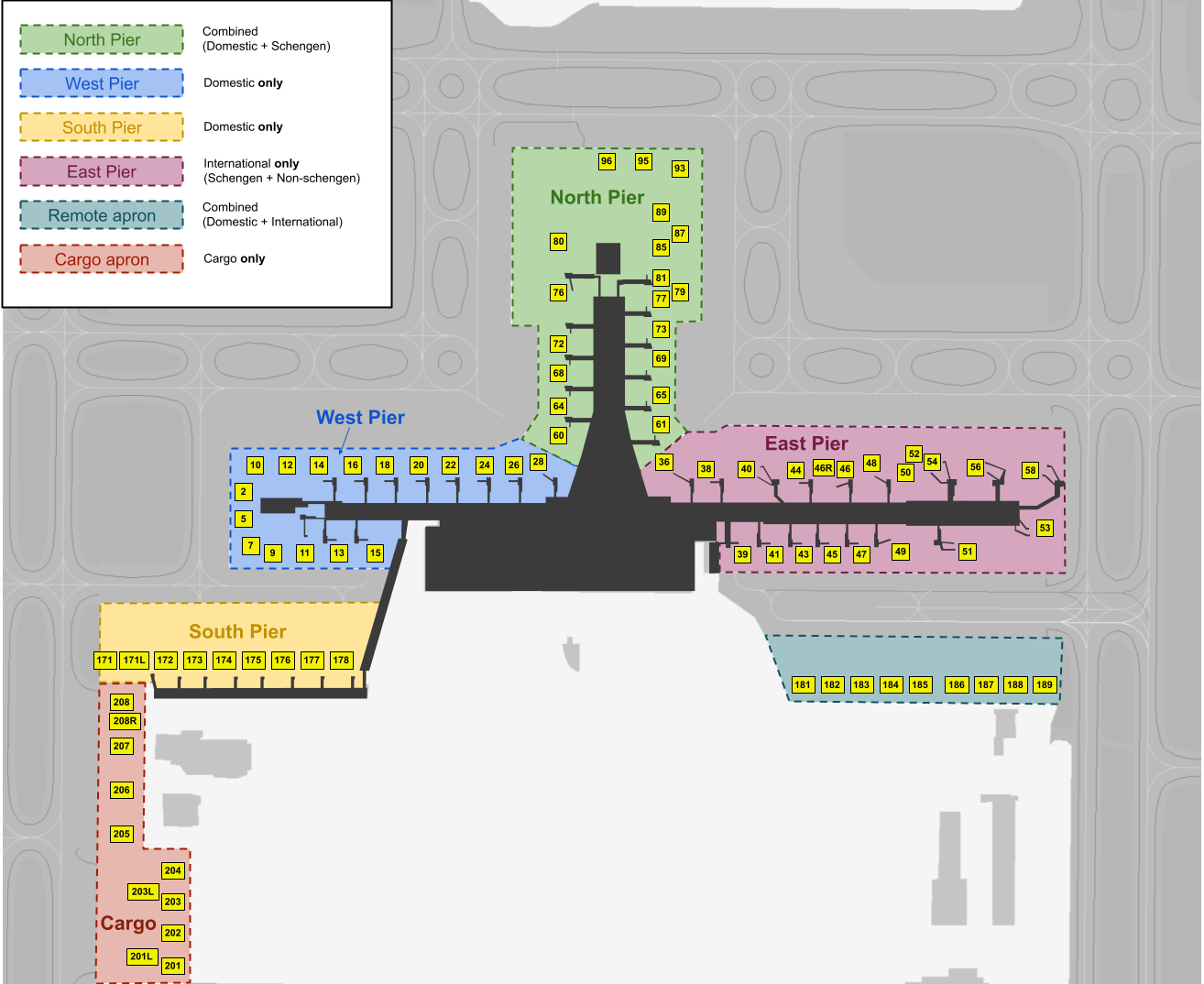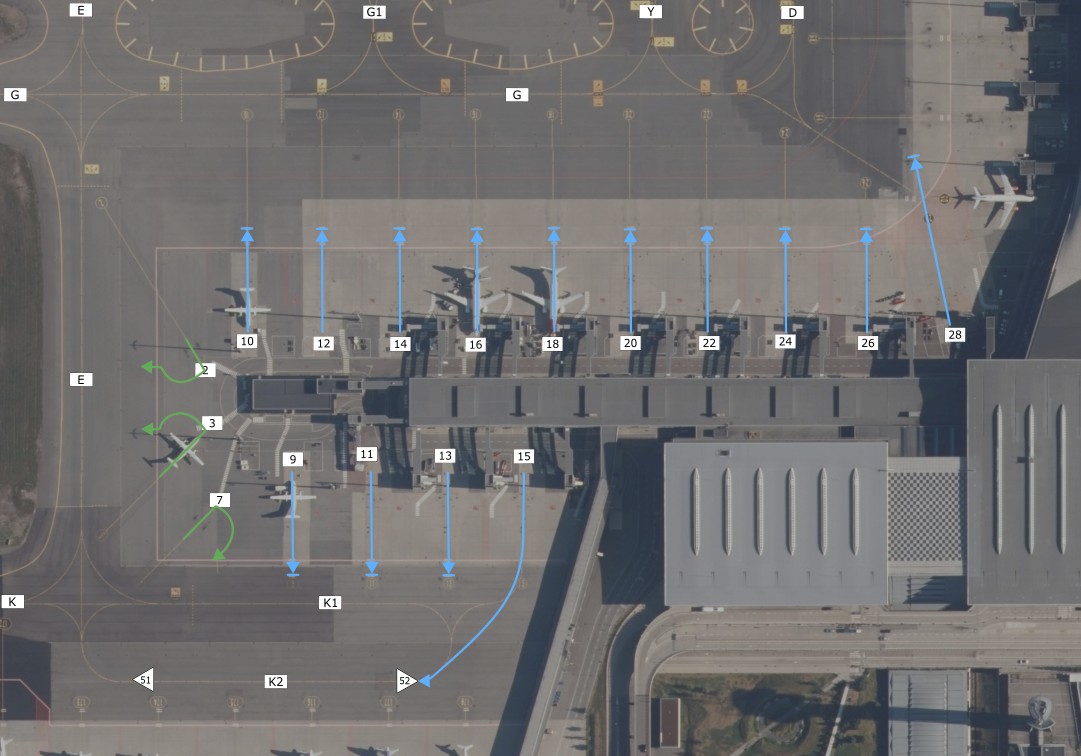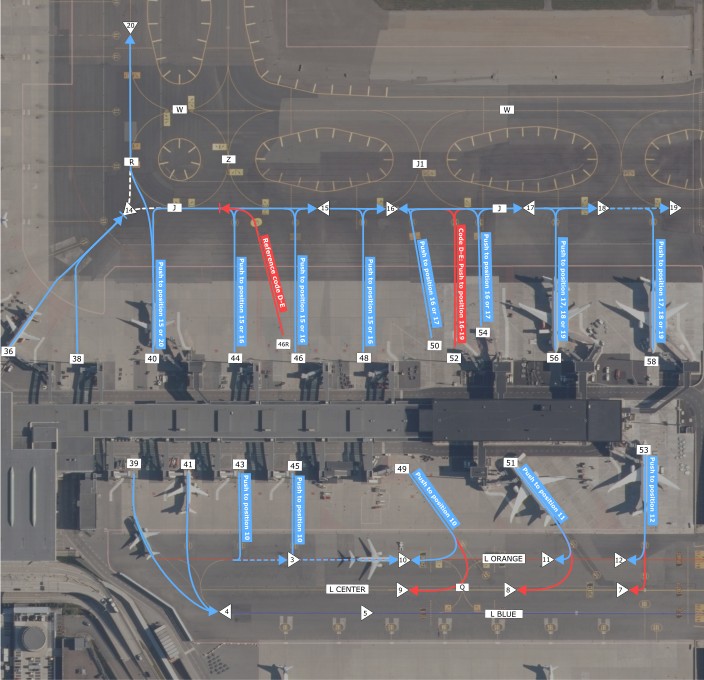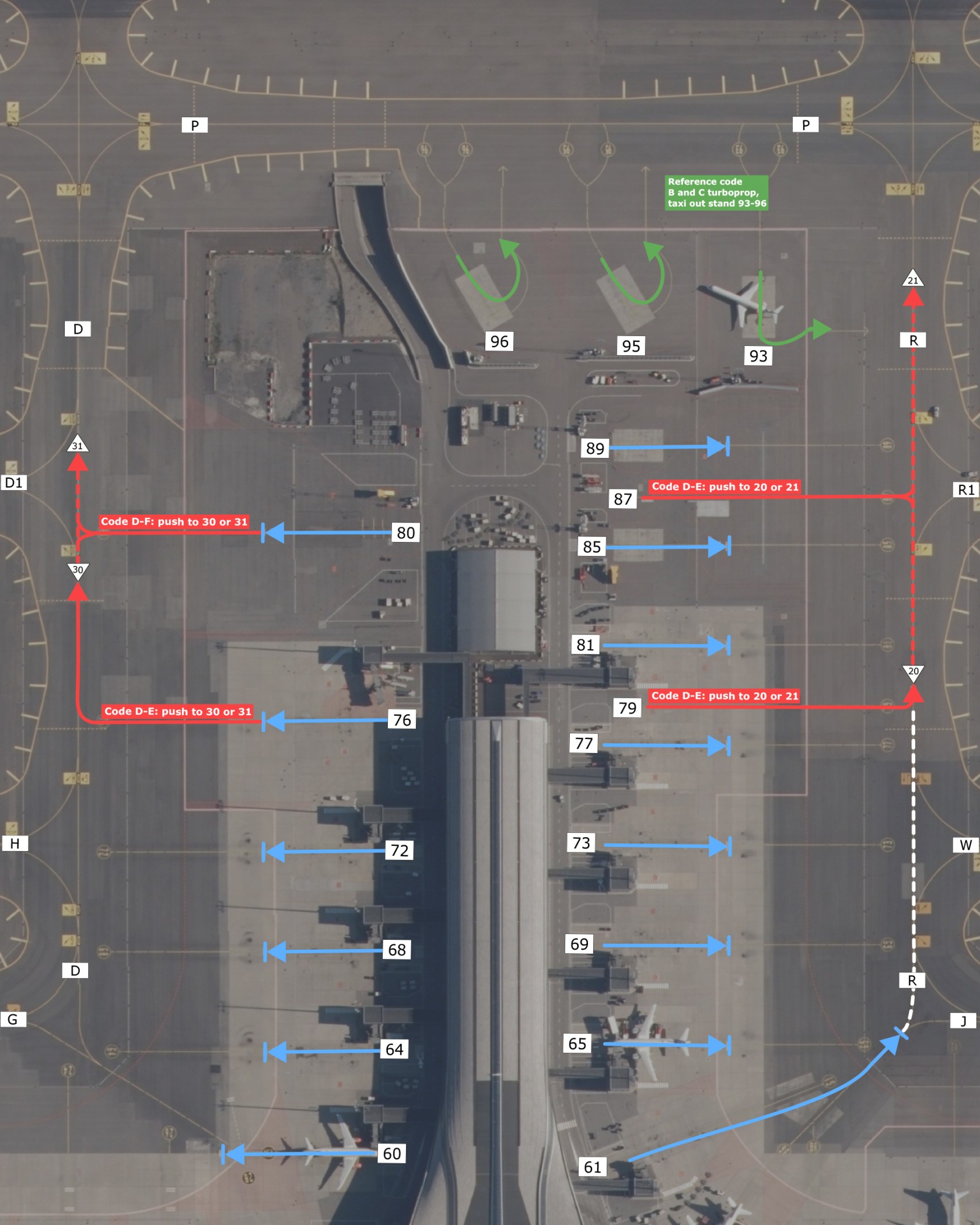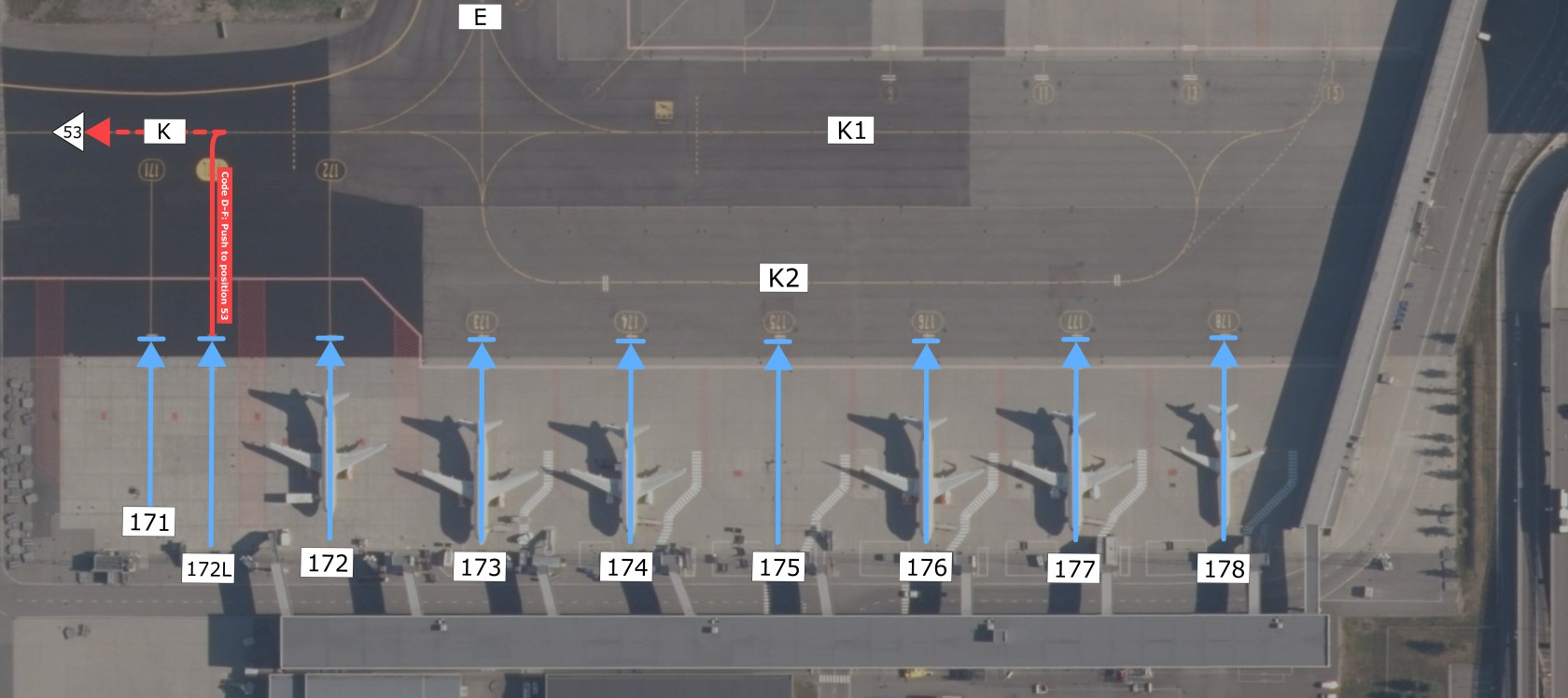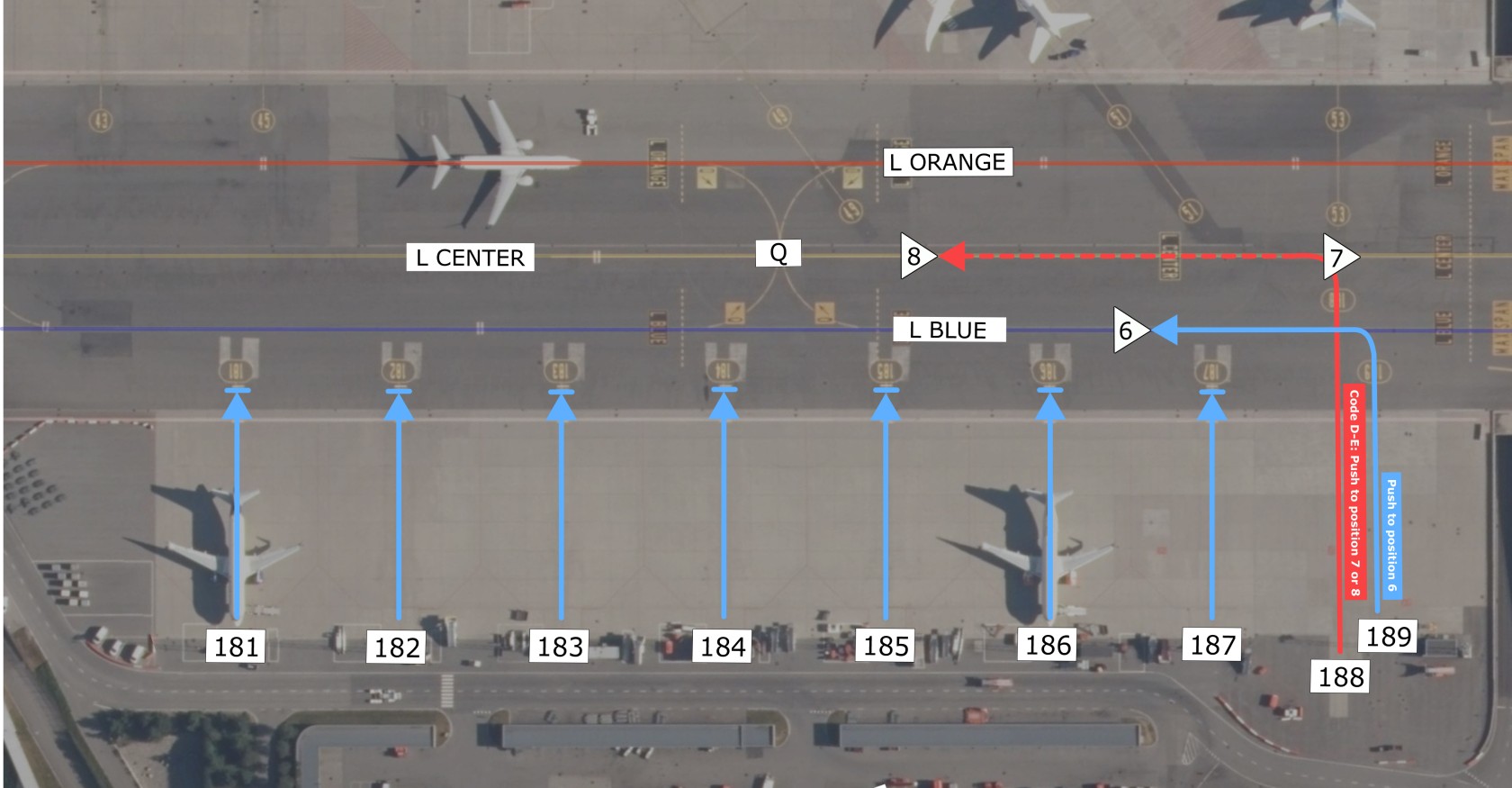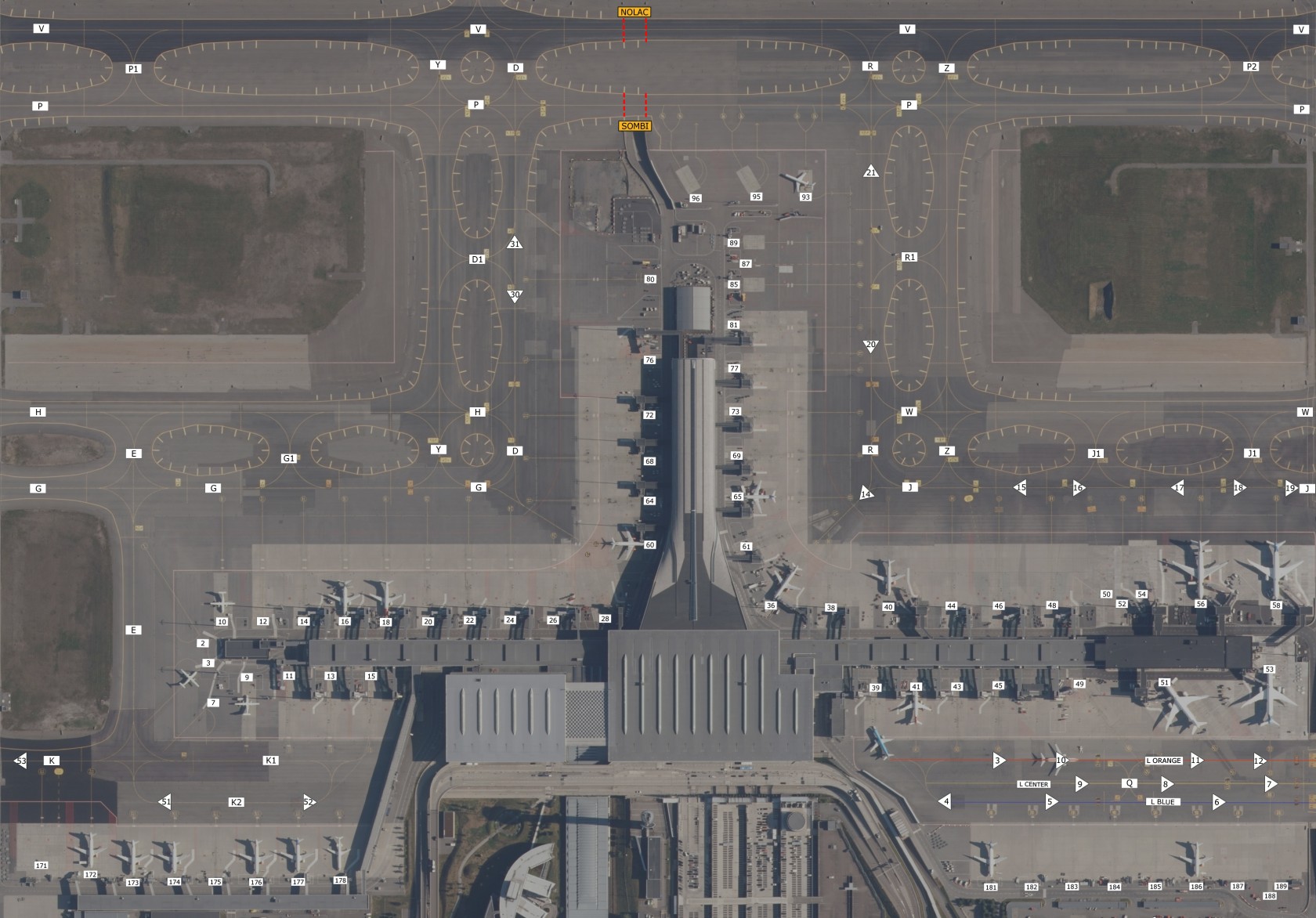ENGM – Oslo Lufthavn
Available stands
Overview
Oslo Airport, Gardermoen is the main airport of the Norwegian capital Oslo, and the main international airport of Norway. Having earlier served as a secondary airport, air force base and charter airport, Gardermoen opened as the new main airport of Oslo on October the 8th 1998, replacing the now closed Fornebu Airport. Today, it has over 22 million passengers passing through each year, with 162 destinations worldwide, from short domestic flights to intercontinental long hauls.
Stands
| Pier/Apron | Stands | Assigned to |
|---|---|---|
| West Pier | 2-28 | Domestic Only |
| East Pier | 36-44 | Schengen only |
| 40-53 | Non-schengen only | |
| North Pier | 60-96 | Domestic & Schengen Only |
| South Pier | 171-178 | Domestic mainly |
| Remote apron | 181-189 | International mainly |
| Cargo Apron | 201-208 | Cargo only |
| GA Apron | 313-332 | General aviaton |
IFR clearance
Initial contact is with Clearance Delivery, reporting callsign, stand number, and latest ATIS identification letter and QNH.
Requesting De-Icing
If you require de-ice prior to your departure, request with your departure clearance request.
DCL: Include clearence request with Remark REQ DEICE
Voice: Upon inital contact with GARDEMOEN DELIVERY, advise if de-ice is required.
Pushback
Most of the terminal gates requires straight-back pushes, however a few have turn-pushes. Please have a look on the maps below to see how you should perform your push from the stand. You can click on the images to have a closer look.
Pushback maps
Taxi
Taxi instructions at Gardermoen includes the full taxi route, however the runway intersection is not always included. If for example “holding point runway xx” is stated in your instruction, you are encouraged to call ATC with “C/S, ready via intersection xx ” as you approach this intersection, and it may be approved if traffic permits. Make sure to double-check if you are able to use the runway length from the intersection before requesting it.
Holding point assignmemt
On runway 01R, always expect to use full length via B1 or B2, due to noise abatement procedures.
If an intersection has not been specified, you may taxi to full-length, or advice ATC if able to depart from any earlier intersection.
Runways
Given that you’ve parked according to the paragraph describing the Use of stands, usually the eastern runway (19L/01R) is used for international departures/arrivals, and the western (19R/01L) for domestic departures/arrivals. This however is not a set rule, and runways are organized to accommodate high traffic loads.
The western runway (19R/01L) has a TORA of 3600m, the eastern runway (19L/01R) has a TORA of 2950m.
During winter operations the airport normally operates with a segregated runway configuration, landing on 01R/19R and departing 01L/19L, due to location of the active de-icing pads.
SIDs
All SIDs are individually numbered for each runway. When receiving your clearance, know that the SID stated is only valid for one runway, in case the controller forgets to state the departure runway. RNAV SIDs at Gardermoen has an initial climb altitude of 7000ft. If you are unable to follow the published SIDs (old AIRAC, default or non-database freeware aircraft, climb gradient etc.), state so when requesting clearance and you will recieve an alternative departure instructions depending on assigned runway and aircraft type.
STARs
Oslo airport Gardermoen is one of the first airports in Europe to use a “Point Merge System”, or PMS. This means that all STARs end up in a “fan” made out of waypoints (study the STAR charts for Gardermoen), in which pilots should always be prepared for a direct routing towards the merge waypoint, 4 in total, in order to ease the workload of approach ATC.
All STARs are valid for both parallel runways, 19L/R or 01L/R. Approach (or Director when online) is to inform you of which runway to expect for landing.
The last fix of the STAR (or Merge Point) is followed by a transition to the ILS approach for each runway. ATC often replace these with vectoring, but always be prepared to fly the transition, and do NOT fly direct from the merge point to the Final Approach Fix. If you have no transitions available, inform ATC and request vectoring.
Study the approach charts, and make sure to always follow altitude and speed restriction, unless otherwise instructed by ATC.
Approach
The default approach to Gardermoen is ILS for all runways. All runways are CAT III equipped. In case of low visibility conditions, only the "right" runway is used for landing (01R or 19R). Curved RNP (AR) approaches are encouraged and may be available on request if traffic permits. (Remember to add T1 to your FPL below PBN/).
Fly at minimum 160 KT IAS to DME 4 GP on ILS approach, 4 NM final for RNP approach, or DME 5 GRM on VOR/DME approach, unless a different speed is instructed by ATC. Advice if unable to follow this restriction.
Visual approach is not approved for jet aircraft and propeller aircraft with MTOW more than 5700 kg.
Direct routings
In Norway, direct routings are often used. Both arriving and departing traffic should be prepared to fly direct the end of SIDs, STAR Merge Points, and airspace border fixes. Make sure you have your filed route and waypoint page available to quickly accommodate direct routings.
Communications
You can always check online positions and sectors by visiting vatglasses.uk
| Main logon | Frequency | Position |
|---|---|---|
| ENGM_A_ATIS | 126.125 | Gardermoen Arrival ATIS |
| ENGM_D_ATIS | 127.150 | Gardermoen Departure ATIS |
| ENGM_W_DEL | 121.680 | Gardermoen Delivery West |
| ENGM_E_DEL | 121.930 | Gardermoen Delivery East |
| ENGM_W_GND | 121.605 | Gardermoen Ground West |
| ENGM_E_GND | 121.905 | Gardermoen Ground East |
| ENGM_P_GND | 121.730 | Gardermoen Ground Planner |
| ENGM_W_TWR | 118.305 | Gardermoen Tower West (01L/19R) |
| ENGM_E_TWR | 120.105 | Gardermoen Tower East (01R/19L) |
| ENGM_W_APP | 120.455 | Oslo Approach West |
| ENGM_E_APP | 118.480 | Oslo Approach East |
| ENGM_D_APP | 136.405 | Oslo Director |
| ENGM_F_APP | 128.905 | Oslo Final |
| ENOS_CTR | 127.255 | Polaris Control (Oslo ACC South) |
| ENOS_N_CTR | 120.380 | Polaris Control (Oslo ACC North) |
| ENOR_S_CTR | 121.550 | Polaris Control (Bandbox South/Covering ENOS+ENSV) |
| ENOR_SC_CTR | 134.515 | Polaris Control (Bandbox South Central/Covering ENOS+ENSV+ENBD_S) |
| ENOR_CTR | 125.500 | Polaris Control (Bandbox) |
| ENRC_S_CTR | 118.425 | Gardemoen Tower (Bodø Remote Tower Center) |

